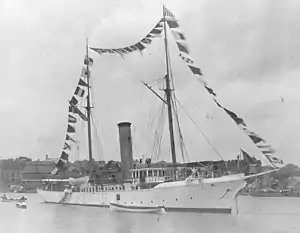USRC Apache
The second USS Apache was a United States Coast Guard cutter that served in the United States Navy as a patrol vessel from 1917-1919.
 | |
| History | |
|---|---|
| Name | Apache |
| Namesake | The Apache, the collective term for several culturally related groups of Native Americans originally from the American Southwest (previous name retained) |
| Builder | Reeder and Sons, Baltimore, Maryland |
| Completed | 1891 |
| Acquired | 1917 |
| Fate | Returned to United States Coast Guard 28 August 1919 |
| Notes | Served as United States Revenue Service cutter USRC Galveston 1891-1900 and as USRC Apache 1900-1915; served in U.S. Coast Guard as cutter USCGC Apache 1915-1917 and 1919-1937; U.S. Army during World War II; scrapped 1950 |
| General characteristics | |
| Type | Patrol vessel |
| Displacement | 708 long tons (719 t) |
| Length | 185 ft 3 in (56.46 m) |
| Beam | 29 ft (8.8 m) |
| Draft | 9 ft 3 in (2.82 m) (mean) |
| Speed | 12 kn (14 mph; 22 km/h) |
| Complement | 58 |
| Armament |
|
Apache was built in 1891 as the United States Revenue Cutter Service cutter USRC Galveston by Reeder and Sons at Baltimore, Maryland. In 1900, her name was changed to USRC Apache and, upon the creation of the U.S. Coast Guard in 1915, she became USCGC Apache.
Service history
On 30 April 1907 she struck the anchored barge C. T. Rowland in fog in Chesapeake Bay at the lower end of the Craighill Channel.[1] Apache entered U.S. Navy service after the U.S. entered World War I in April 1917 and the Coast Guard came under U.S. Navy control for the duration of the war. She was assigned to the 5th Naval District and patrolled Chesapeake Bay until the end of the war.
Apache returned to U.S. Coast Guard control when the Coast Guard was returned to the jurisdiction of the U.S. Department of the Treasury on 28 August 1919. She remained active in the Coast Guard until 1937, then saw service with the United States Army in the Pacific during World War II before being scrapped in 1950.
References
- "Annual report of the Supervising Inspector-general Steamboat-inspection Service, Year ending June 30, 1908". Harvard University. Retrieved 20 September 2019.
- This article incorporates text from the public domain Dictionary of American Naval Fighting Ships. The entry can be found here.
- United States Coast Guard Historian's Office: Webcutters: Apache (1891); originally named Galveston